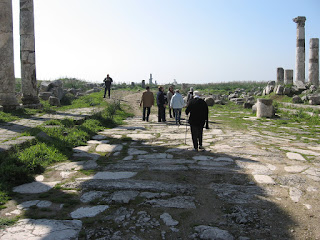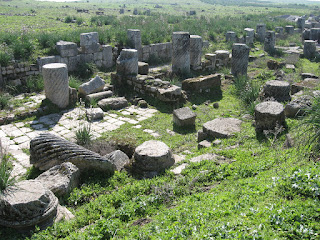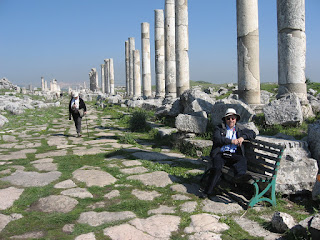Apamea (Greek: Ἀπάμεια, Apameia; Arabic: آفاميا, Afamia), on the right bank of the Orontes River, was an ancient Greek and Roman city. It was the capital of Apamene under the Macedonians, became the capital and Metropolitan Archbishopric of late Roman province Syria Secunda, again in the crusader time and since the 20th century a quadruple Catholic titular see.
Amongst the impressive ancient remains, the site includes the Great Colonnade which ran for nearly 2 km (1.2 mi) making it among the longest in the Roman world and the Roman Theatre, one of the largest surviving theatres of the Roman Empire with an estimated seating capacity in excess of 20,000. The site is about 55 km (34 mi) to the northwest of Hama, Syria, overlooking the Ghab valley.
Many remains of the ancient acropolis are still standing, consisting probably of the remains of the temples of a highly ornamental character and of which Sozomen speaks; it is now enclosed in ancient castle walls called Kalat el-Mudik (Kŭlat el-Mudîk); the remainder of the ancient city is to be found in the plain.
The most significant collection of objects from the site, including many significant architectonic and artistic objects, that can be seen outside of Syria are in Brussels at the Cinquantenaire Museum.
Source: Apamea, Syria - Wikipedia
Amongst the impressive ancient remains, the site includes the Great Colonnade which ran for nearly 2 km (1.2 mi) making it among the longest in the Roman world and the Roman Theatre, one of the largest surviving theatres of the Roman Empire with an estimated seating capacity in excess of 20,000. The site is about 55 km (34 mi) to the northwest of Hama, Syria, overlooking the Ghab valley.
Many remains of the ancient acropolis are still standing, consisting probably of the remains of the temples of a highly ornamental character and of which Sozomen speaks; it is now enclosed in ancient castle walls called Kalat el-Mudik (Kŭlat el-Mudîk); the remainder of the ancient city is to be found in the plain.
The most significant collection of objects from the site, including many significant architectonic and artistic objects, that can be seen outside of Syria are in Brussels at the Cinquantenaire Museum.
⚠ Alert
As a result of the civil war in Syria, the ancient city has been damaged and looted by treasure hunters. In April 2017, Al-Masdar News published satellite photographs revealing the site was covered in hundreds of holes dug by treasure hunters seeking ancient artifacts.
As a result of the civil war in Syria, the ancient city has been damaged and looted by treasure hunters. In April 2017, Al-Masdar News published satellite photographs revealing the site was covered in hundreds of holes dug by treasure hunters seeking ancient artifacts.
Google Earth Image of Apamea, Syria, in 2012 after it was looted. © Google Earth
Source: Apamea, Syria - Wikipedia










































































































































